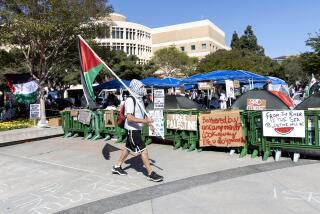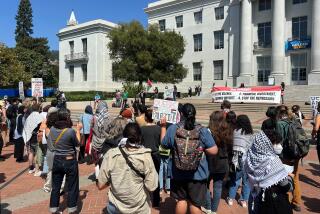SEQUEL / THE BERKELEY FREE SPEECH MOVEMENT : Agents of Change : In 1964, Mario Savio and his colleagues demanded to be heard on civil rights and were arrested for it. Today, many FSM alums are speaking out for other causes.
- Share via
No one who remembers Mario Savio could get very excited about this year’s prime examples of student protest--Bill Clinton and Berkeley’s Naked Guy.
Savio was the spokesman of the Berkeley Free Speech Movement, the opening salvo of decades of student protest. It was Savio who climbed atop a campus police car in October, 1964, and with oft-described “fiery eloquence” addressed a crowd of 10,000. They were challenging the university’s ban on proselytizing for non-campus causes--civil rights, world peace--on university property.
He climbed down into history and legend. For a while, he devoted himself to public speaking and private pronouncements, then he shrank from statement and, finally, from view.
It was a case, says Berkeley artist David Goines, a former FSM member, “of the times looking around for a man, finding him, then dropping him like a brick.”
Savio became such a mysterious figure that people rushed to explain his eventual silence. Some say he was hounded into obscurity by the media. Some say he was always shy, even fragile.
“We didn’t have leaders in the ordinary sense,” says Michael Rossman, a Berkeley teacher who was on the FSM’s steering committee. “But everyone (in the media) wanted to know who was the leader because they had to have one, and Mario was eloquent, photogenic, his line was unique. . . . He was the charismatic leader of the most important movement in America, but the sensibility which gave him his status amongst us would never let him say ‘me me me.’ (He) hated the attention because it was not him.”
In fall ‘64, many FSM participants had spent their summer working for civil rights in the South. “People had tried to kill them that summer,” says Goines, “and they came back to Cal and were told they couldn’t set up their tables and speak out for civil rights on the campus.”
The movement’s goal was simple: The students wanted only the right to speak. According to FSM alumna Jackie Goldberg, past president of the Los Angeles Board of Education, it unified disparate groups--the left, the right, the Sierra Club, “97 shades of socialism, 14 Republican groups, who would never have unified without an outside enemy that said, ‘A ban on all of you.’ ”
Savio, president of the campus Student Non-Violent Coordinating Committee (SNCC) chapter, was described as shy and stuttering--until Oct. 1. Then an ex-student named Jack Weinberg was seized for passing out leaflets and held in the police car for 32 hours while Savio stood on the roof and addressed the mob.
Eight, including Savio, were arrested in the earliest demonstrations. Another 800 or so, including Savio, were hauled in when the FSM staged a big December sit-in. The university granted the right to speak on campus, but demonstrations, arrests, trials and sentencings made headlines for years.
Not surprisingly, many FSM participants found their career plans derailed, or at least re-railed. Even less surprising, activism of some sort became a permanent part of their lives.
- Jack Weinberg, who had dropped out of graduate school in math and was chairman of the Berkeley chapter of Congress of Racial Equality (CORE) in the fall of 1964, served 120 days in jail. He finished the decade in California, occupied with anti-war activities, “radical Berkeley politics,” and the organization of California’s Peace and Freedom Party.
Then, wanting to “revitalize the labor unions,” he became a union activist, working on auto assembly lines in Southern California and Michigan, and then at U.S. Steel in Gary, Ind., until his job was eliminated in 1984.
While in Gary, first at U.S. Steel and later at a small topography shop, he turned to environmental matters--stopping a nuclear plant and organizing the Northwest Indiana Clean Air Coalition. In 1989 he joined Greenpeace International as coordinator of its Great Lakes project. Activism is now his job as well as his life: In the one period of adulthood that Weinberg, now 52, wasn’t working on some cause, “I was lost,” he says.
- David Goines was a sophomore that fall, an intended classics major, and one of the original eight arrested. He, too, was active in civil rights work, and in Slate, Berkeley’s indigenous group of student activists.
He drew two months of jail time for demonstrating, but more often he was printing FSM literature and, later, “anti-war stuff,” at the Berkeley Free Press. “If you were counterculture,” he says, “you went to the Berkeley Free Press.” A graphic artist, he now runs St. Hieronymus Press in Berkeley and is writing a book on the movement.
- Jackie Goldberg paid a fine for her participation, probably, she says now, because “I said, ‘I’m broke, please send me to jail.’ ” When she graduated, a Phi Beta Kappa, she was rejected by graduate schools. The University of Chicago finally admitted her, but then her master’s degree was held up while she tried to get a required internship: “The Chicago public schools said, ‘We don’t hire people like you.’ I thought I’d never be able to teach.”
Back in Los Angeles, she was refused jobs even in a teacher shortage, and waited more than a year for her credentials while “they lost my fingerprints, then my health records, then my transcripts.” The official ostracism didn’t end, she says, until she won election, then reelection to L.A.’s school board, serving from 1983 to 1991, her last two years as president. She’s now running for the Los Angeles City Council.
- Goldberg’s brother Art--another of the original eight--also felt the shadow of the FSM on his career. He went to law school and passed the bar exam in 1969, but, given his FSM background, arrest record and 120 days in jail, had two years of hearings and delay before being admitted to the State Bar.
- Sandor Fuchs, another of the eight, now works with Art Goldberg running the Working People’s Law Center in Echo Park. Fuchs had less trouble. Continuing his “cultural / political / radical” activities, he went on to graduate school in economics but quit in 1972 to study law--by the old-fashioned method of apprenticeship. When he passed the bar in 1976, he satisfied questions about his ethics “with letters of recommendation saying these things (such as arrest record) were not a sign of moral turpitude.”
Concentrating on personal injury and civil rights, he now says he “chose the law in part because I could continue to be a radical.”
- Teaching of various kinds has drawn a fair number of FSM alums:
-- Bettina Aptheker, the group’s best-known avowed Communist, is an associate professor and chairperson of the women’s studies program at UC Santa Cruz.
-- Michael Rossman, who also writes books and articles and collects 1960s political posters, teaches science in a private elementary school.
Savio, true to legend, is now very quiet. (He would not speak for this article.)
Oddly, he neither shrank from leadership nor sought obscurity at a time when he had the former and the possibility of the latter seemed remote. He had to be dragged off stages, shut out of official meetings. He did TV interviews, a national tour; he made courtroom pronouncements about the “shameless hypocrisy” of the court.
Much of the time, he wasn’t a student, having dropped out and been denied readmission. Nor was he speaking for the FSM, which had essentially disbanded when the basic battle was won. For several more years, he joined, and sometimes led demonstrations for, other causes.
Then it was over: He withdrew, and when contacted, avoided or refused interviews. His reasons were personal--a failed first marriage, an unfinished degree, among other things--he once said.
He was “not himself,” said some old friends. Others said he was just being himself, basically shy and retiring, a “gentle poet type,” in Jackie Goldberg’s words.
Whatever else he was, he was out of the radical loop, maybe not entirely by choice. In 1974, for example, when he was teaching at an alternative school in Los Angeles, he wrote a newspaper commentary on police excess in the pursuit of Patty Hearst’s kidnapers. Its impetus was his outrage at a reporter’s notion that Savio might still be in the loop and have some connection to the East Bay-based Symbionese Liberation Army.
In the past decade, he has surfaced periodically. In 1984 he spoke at a Berkeley rally on the 20th anniversary of the Free Speech Movement and in June, 1988, at the graduation of one of his sons from Sidwell Friends School in Washington.
In 1984, he received a bachelor’s degree in physics--summa cum laude and Phi Beta Kappa--from San Francisco State, and in 1989, a master’s. He now teaches physics and math “in Northern California,” says Michael Rossman, who describes himself as Savio’s “contact point.”
A normal life, if not the stuff of legend. But then, what becomes a legend most? Could anything measure up?
Janet Lundblad in the Editorial Library contributed to the research on this article.
More to Read
Sign up for Essential California
The most important California stories and recommendations in your inbox every morning.
You may occasionally receive promotional content from the Los Angeles Times.










